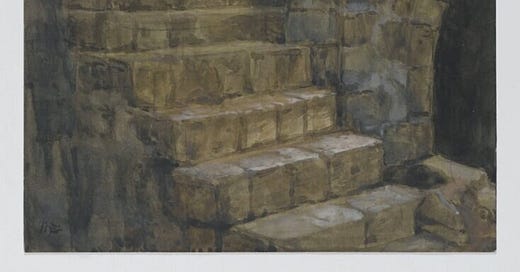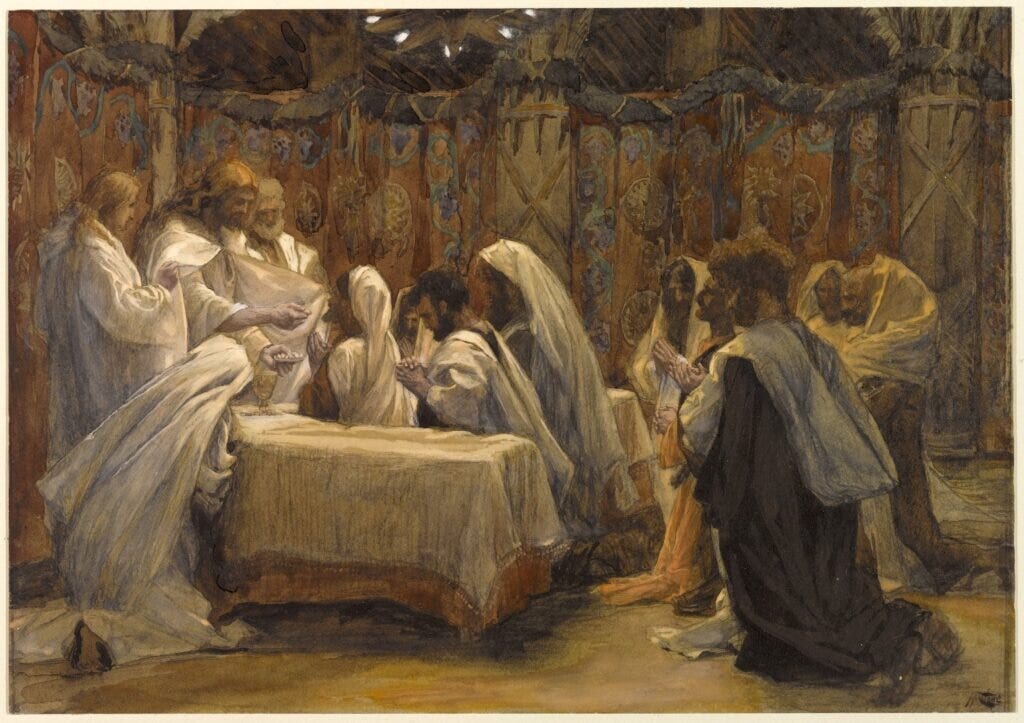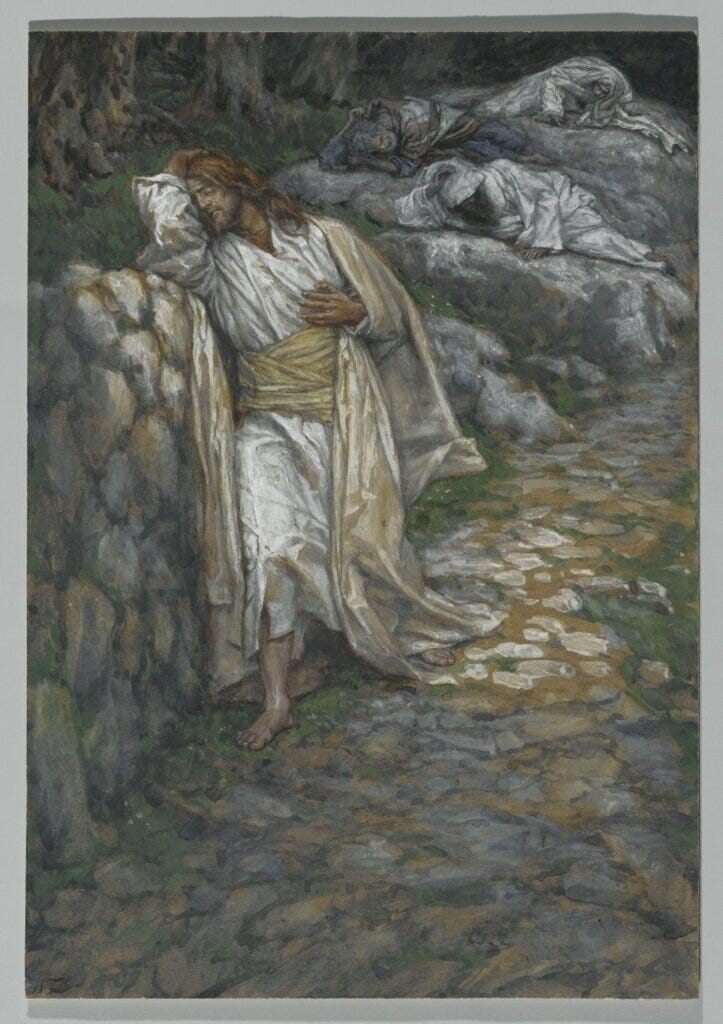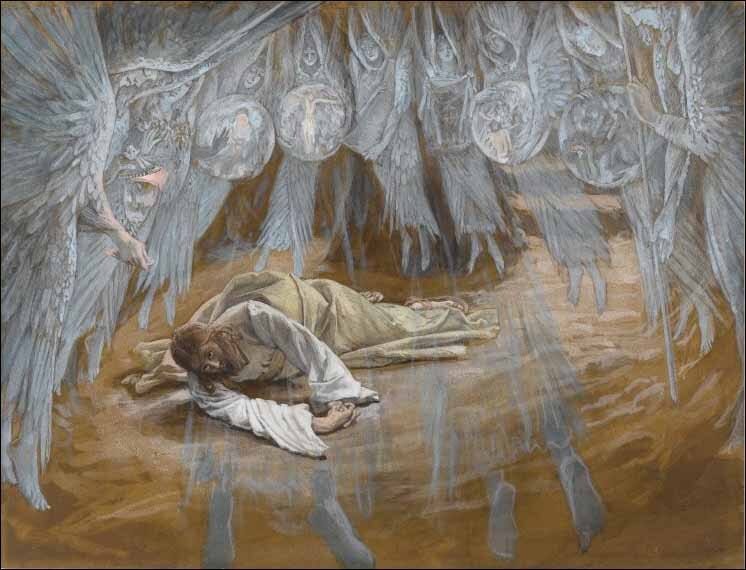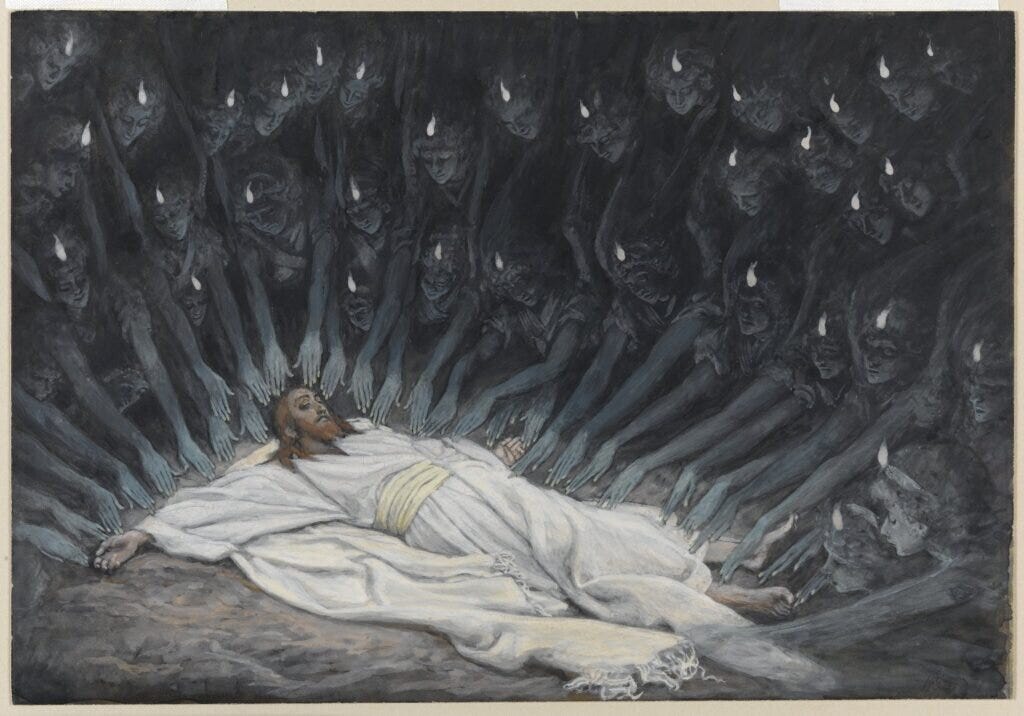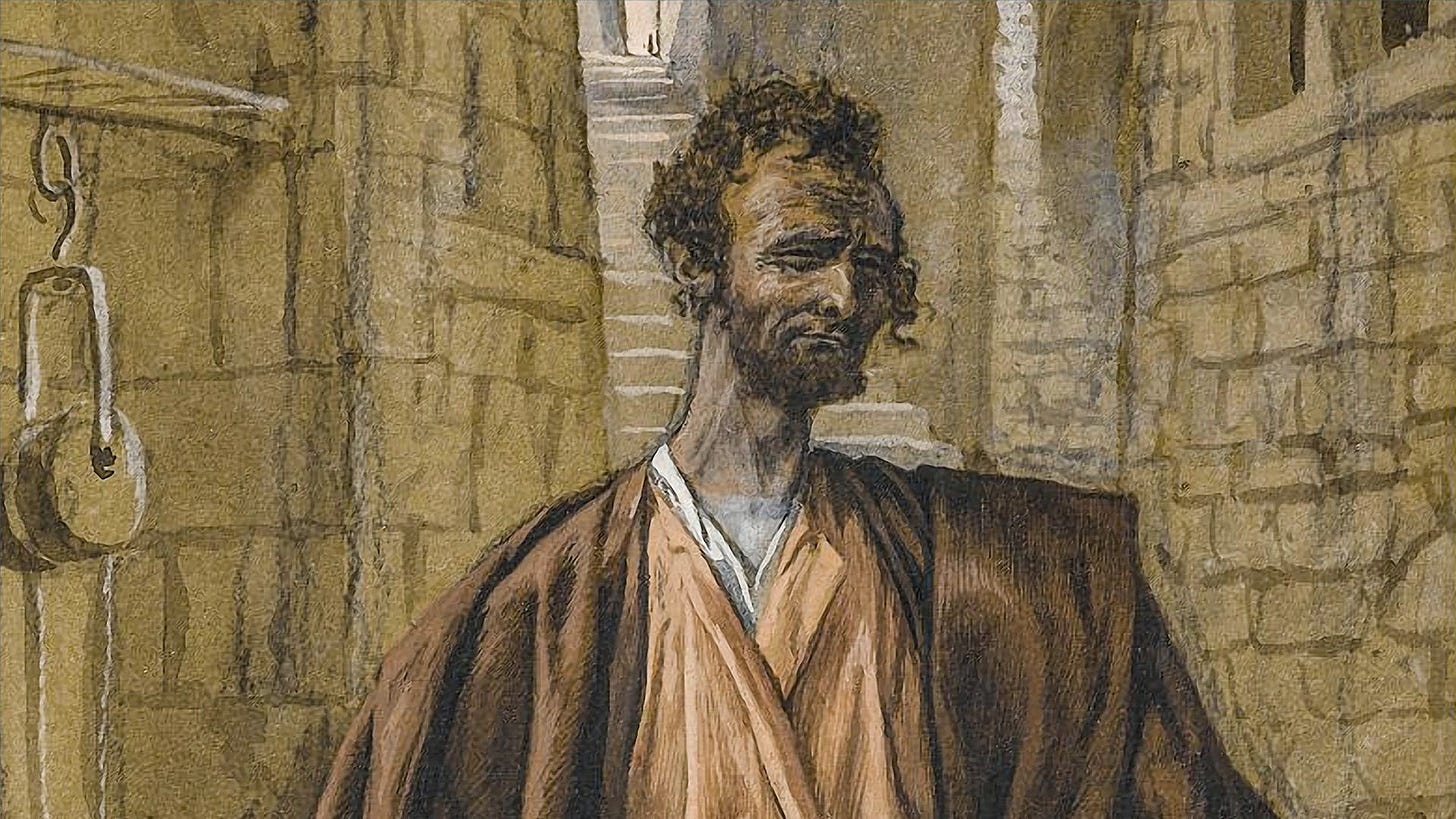Holy Thursday or Maundy Thursday, Illustrated with Scriptures and Commentary
By James Tissot and Dom Guéranger
Another common name for Holy Thursday is "Maundy Thursday." Maundy comes from the Latin word mandātum, which means "command" or "mandate.” It refers to Jesus' words "I give you a new commandment" after washing his disciples' feet during the Last Supper. The new commandment is to "Love one another as I have loved you.”
Selected illustrations for Holy Thursday
+ The Evil Counsel
+ The Last Supper
+ The Communion of the Apostles
+ Judas Retires from the Supper
+ My Soul Is Exceedingly Sorrowful unto Death
+ Agony in the Garden
+ Jesus Ministered to by Angels
+ Judas Kiss
James Tissot did so many illustrations for this immensely significant holy day, that I have only included a portion. The titles of any Tissot illustrations for Holy Thursday not shown on this page are linked to where the images may be viewed at another site with accompanying Bible verses.
From Dom Guéranger's The Liturgical Year.
“This is the first day of the Azymes, or feast of the unleavened bread. At sunset, the Jews must eat the Pasch in Jerusalem. Jesus is still in Bethania; but He will return to the city before the hour for the paschal supper. The Law commands this; and, until He has abrogated the Law by the shedding of His Blood, He wishes to observe its ordinances. He therefore sends two of His disciples to get everything ready for the Pasch, without, however, telling them the great mystery wherewith it is to terminate. We, who know that at this last Supper was instituted the Sacrament of the Eucharist, can understand why He sends Peter and John, in preference to any of the other disciples, to prepare what is needed. Peter, who was the first to confess the Divinity of Jesus, represents faith: and John, who leaned upon the breast of the Man-God, represents love. The mystery, which is to be instituted at to-night’s Supper, is revealed to love by faith. It is this that Jesus would have us learn from His choice of the two apostles; but they themselves see not the intention of their Master.
“Jesus, who knows all things, tells them by what sign they are to know the house, which He intends to honour with His presence: they have but to follow a man, whom they will see carrying a pitcher of water. The house to which this man is going belongs to a rich Jew, who recognizes Jesus as the Messias. The two apostles apprise him of their Master’s wishes; and immediately he puts at their disposal a large and richly furnished room. It was fitting that the place where the most august mystery was to be instituted should be something above the common. This room, where the reality was to be substituted for all the ancient figures, was far superior to the temple of Jerusalem. In it was to be erected the first altar for the offering up of the clean oblation foretold by the prophet; in it was to commence the Christian priesthood; in it, finally, fifty days later on, the Church of Christ, collected together and visited by the Holy Ghost, was to make herself known to the world, and promulgate the new and universal Covenant of God with men. This favoured sanctuary of our faith is still venerated on Mount Sion. . . .
“During the course of the day, Jesus has entered Jerusalem, with the rest of His disciples: He has found all things prepared.
“The Paschal Lamb, after being first presented in the temple, has been brought to the house, where Jesus is to celebrate the Supper; it is prepared together with the wild lettuce and the unleavened bread.
“In a few hours, the divine Master and His disciples will be standing round the table, their loins girt, and staves in their hands: and, for the last time, they will observe the solemn rite prescribed by God to His people when they first went forth from Egypt. . . .
“The Church intends, on this day, to renew, in a most solemn manner, the mystery of the last Supper: for our Lord Himself, on this occasion of the institution of the blessed Sacrament, said to His apostles: ‘Do this for a commemoration of Me.’ . . .
“Jesus is in the supper chamber, where the Paschal lamb is to be eaten. All the apostles are with Him; Judas is there, also, but his crime is not known to the rest. Jesus approaches the table, on which the lamb is served. His disciples stand around Him. The ceremonies prescribed by God to Moses are religiously observed. At the beginning of the repast, Jesus speaks these words to His apostles: ‘With desire I have desired to eat this Pasch with you, before I suffer.’ In saying this, He does not imply that the Pasch of this year is intrinsically better than those that have preceded it; but that it is dearer to Him, inasmuch as it is to give rise to the institution of the new Pasch, which He has prepared for mankind, and which He is now going to give them as His last gift; for, as St. John says, having loved His own, who were in the world, He loved them unto the end.
“During the repast, Jesus, who reads the hearts of all men, utters these words, which cause great consternation among the disciples: ‘Amen I say to you that one of you is about to betray Me:—he that dippeth his hand with Me in the dish, he shall betray Me.’The sadness with which He speaks is enough to soften any heart; and Judas, who knows his Master’s goodness, feels that they imply a merciful pardon, if he will but ask it. But no: the passion of avarice has enslaved his soul, and he, like the rest of the apostles, says to Jesus: ‘Is it I, Rabbi?’ Jesus answers him in a whisper, in order not to compromise him before his brethren: ‘Thou hast said it!’ But Judas yields not. He intends to remain with Jesus, until the hour comes for betraying Him. Thus, the august mystery, which is on the point of being celebrated, is to be insulted by his presence! The legal repast is over. It is followed by a feast, which again brings the disciples around their divine Master.
“It was the custom in the east, that guests should repose two and two on couches round the table: these have been provided by the disciple who has placed his house at Jesus’ service. John is on the same couch as Jesus, so that it is easy for him to lean his head on his Master’s breast. Peter is on the next couch, on the other side of Jesus, who is thus between the two disciples whom He had sent, in the morning, to prepare the Pasch, and who, as we have already observed, represent faith and love. The second repast is a sorrowful one, in consequence of Jesus having told the guests that one of them is a traitor. The innocent and affectionate John is overwhelmed with grief, and seeks consolation on the Heart of his dear Lord, whom some one is about to deliver to His enemies.
“But the apostles little expect a third supper; Jesus has not told them of His intention; but He had made a promise, and He would fulfil it before His Passion. Speaking, one day, to the people, He had said: ‘I am the living bread which came down from heaven: if any man eat of this bread, he shall live for ever, and the bread that I will give, is My Flesh for the life of the world... My Flesh is meat indeed, and My Blood is drink indeed. He that eateth My Flesh and drinketh My Blood, abideth in Me, and I in him.’ The time has come for the fulfilment of this His loving promise. But as it was both His Flesh and His Blood that He promised us, He waited till the time of His sacrifice. His Passion has begun; He is sold to His enemies; His life is already in their hands:—He may at once, therefore, offer Himself in sacrifice, and give to His disciples the very Flesh and Blood of the Victim.
“As soon as the second repast is over, Jesus suddenly rises, and, to the astonishment of His apostles, takes off His upper garment, girds Himself as a servant with a towel, pours water into a basin, and prepares to wash the feet of the guests. It was the custom, in the east, to wash one’s feet before taking part in a feast; it was considered as the very extreme of hospitality, when the master of the house himself did this service to his guest. Jesus is about to regale His apostles with a divine banquet; He wishes to treat them with every possible mark of welcome and attention. But in this, as in every other action of His, there is a fund of instruction: He would teach us, by what He is now doing, how great is the purity wherewith we should approach the holy Table. ‘He that is washed,’ says He, ‘needeth not but to wash his feet;’ as though He would say: ‘The holiness of this Table is such, that those who come to it should not only be free from grievous sins, but they should, moreover, strive to cleanse their souls from those lesser faults, which come from contact with the world, and are like the dust that covers the feet of one that walks on the high-way.’ We will explain further on the other teachings conveyed by this action of our Lord.
“It is with Peter, the future head of His Church, that Jesus begins. The apostle protests; he declares that he will never permit his Master to humble Himself so low as this: but he is obliged to yield. The other apostles (who, as Peter himself, are reclining upon their couches) receive the same mark of love: Jesus comes to each of them in turn, and washes their feet. Judas is not excepted: he has just received a second warning from his merciful Master; for Jesus, addressing Himself to all the apostles, said to them: ‘You are clean, but not all’: but the reproach produced no effect upon this hardened heart. Having finished washing the feet of the twelve, Jesus resumes His place, side by side with John.
“Then taking a piece of the unleavened bread, that had remained over from the feast, He raises His eyes to heaven, blesses the bread, breaks it, and distributes it to His disciples saying to them: ‘Take ye, and eat; this is My Body’. The apostles take the bread, which is now changed into the Body of their divine Master; they eat: and Jesus is now not only with them, but in them. But, as this sacred mystery is not only the most holy of the Sacraments, but moreover a true Sacrifice; and as a Sacrifice requires the shedding of blood; our Jesus takes the cup, and changing the wine into His own Blood, He passes it round to His disciples, saying to them: ‘Drink ye all, of this; for this is My Blood of the new testament, which shall be shed for many, unto remission of sins’. The apostles drink from the sacred chalice thus proffered them! When it comes to Judas, he too partakes of it, but he drinks his own damnation, as he ate his own judgment when he received the Bread of life. Jesus, however, mercifully offers the traitor another grace, by saying, as He gives the cup to His disciples: ‘The hand of him that betrayeth Me is with Me on the table’.
“Peter is struck by Jesus thus frequently alluding to the crime, which is to be committed by one of the twelve. He is determined to find out who the traitor is. Not daring himself to ask Jesus, at whose right hand he is sitting, he makes a sign to John, who is on the other side, and begs him to put the question. John leans on Jesus’ breast, and says to Him in a whisper: ‘Lord, who is it?’ Jesus answers him in an equally suppressed tone: ‘He to whom I shall reach bread dipped.’ And having taken one of the pieces of bread that remained over from the repast, He dipped it, and gave it to Judas. It was one more grace offered and refused, for the evangelist adds: ‘And after the morsel, satan entered into him.’ Jesus again addresses him saying: ‘That which thou dost, do quickly.’ The wretch then leaves the room, and sets about the perpetration of his crime. . . .
“The institution of the holy Eucharist, both as a Sacrament and a Sacrifice, is followed by another: the institution of a new priesthood. How could our Saviour have said: ‘Except you eat the Flesh of the Son of man, and drink His Blood, you shall not have life in you,’ unless He had resolved to establish a ministry upon earth, whereby He would renew, even to the end of time, the great mystery He thus commands us to receive? He begins it to-day, in the cenacle. The twelve apostles are the first to partake of it; but observe what He says to them: ‘Do this for a commemoration of Me.’ By these words, He gives them power to change bread into His Body, and wine into His Blood; and this sublime power shall be perpetuated in the Church, by holy Ordination, even to the end of the world. Jesus will continue to operate, by the ministry of mortal and sinful men, the mystery of the last Supper. By thus enriching His Church with the one and perpetual Sacrifice, He also gives us the means of abiding in Him, for He gives us, as He promised, the Bread of heaven. To-day, then, we keep the anniversary, not only of the institution of the holy Eucharist, but also of the equally wonderful institution of the Christian priesthood.”
The Evil Counsel
Matthew 26:1-5: "When Jesus had finished saying all these things, he said to his disciples, 'As you know, the Passover is two days away—and the Son of Man will be handed over to be crucified.' Then the chief priests and the elders of the people assembled in the palace of the high priest, whose name was Caiaphas, and they plotted to arrest Jesus in some sly way and kill him. 'But not during the Feast," they said, 'or there may be a riot among the people.'"
Brooklyn Museum Commentary: "In John’s account, the Pharisees seek the counsel of the chief priest Caiaphas, fearful that Jesus’ growing ministry will provoke the wrath of the Romans and thereby jeopardize the Jewish nation. For the sake of political expediency, Caiaphas urges the priests to find a way to kill Jesus." Tissot emphasizes the clandestine nature of the meeting by placing the participants at the top of the stair, at a distance from the viewer, a rare compositional strategy. Their turned backs and black hoods accentuate the sense of conspiracy."
Jesus Going to the Mount of Olives at Night
Man Bearing a Pitcher
The Last Supper
Luke 22:14-16: "When the hour came, Jesus and his apostles reclined at the table. And he said to them, 'I have eagerly desired to eat this Passover with you before I suffer. For I tell you, I will not eat it again until it finds fulfillment in the kingdom of God.'"
The Last Supper: Judas dipping his hand in the dish
The Washing of the Feet
The Communion of the Apostles
Luke 22:14-16: “When the hour came, Jesus and his apostles reclined at the table. And he said to them, 'I have eagerly desired to eat this Passover with you before I suffer. For I tell you, I will not eat it again until it finds fulfillment in the kingdom of God.'"
Matthew 26:26-29: “While they were eating, Jesus took bread, gave thanks and broke it, and gave it to his disciples, saying, 'Take and eat; this is my body.' Then he took the cup, gave thanks and offered it to them, saying, ‘Drink from it, all of you. This is my blood of the covenant, which is poured out for many for the forgiveness of sins. I tell you, I will not drink of this fruit of the vine from now on until that day when I drink it anew with you in my Father's kingdom.'"
Judas Retires from the Supper
Last Discourse of Our Lord Jesus
Our Lord Jesus Christ*
Address to Philip: 'He who has seen me has seen the Father.'
Protestations of St. Peter: 'Although all shall fall away, yet I will not.'
St. Peter*
My Soul Is Exceedingly Sorrowful Unto Death
Mark 14:32-36: "They went to a place called Gethsemane, and Jesus said to his disciples, 'Sit here while I pray.' He took Peter, James and John along with him, and he began to be deeply distressed and troubled. ‘My soul is overwhelmed with sorrow to the point of death,’ he said to them. ‘Stay here and keep watch.’ Going a little farther, he fell to the ground and prayed that if possible the hour might pass from him. 'Abba, Father,' he said, 'everything is possible for you. Take this cup from me. Yet not what I will, but what you will.'"
Agony in the Garden
Luke 22:41, 43-44: "He withdrew about a stone's throw beyond them, knelt down and prayed, 'Father, if you are willing, take this cup from me; yet not my will, but yours be done.' An angel from heaven appeared to him and strengthened him. And being in anguish, he prayed more earnestly, and his sweat was like drops of blood falling to the ground."
Brooklyn Museum Commentary: Following the Last Supper, Jesus and the apostles retreat to Gethsemane (an olive grove) on the Mount of Olives. While his disciples rest, Christ prays alone, asking God if it is possible to let his sufferings pass him by, yet reaffirming his commitment to submit to God’s will. . . . While one angel holds a chalice—the cup of Jesus’ suffering—the others proffer globes with scenes of the Passion to come, including Veronica’s veil, the Crucifixion, and the lamentation of the Virgin Mary."
You Could Not Watch One Hour with Me
Jesus Ministered to by Angels
Luke 22:42: "An angel from heaven appeared to him and strengthened him."
Judas Approaches with a Large Crowd
Judas Kiss
Matthew 26:48-50: "Now the betrayer had arranged a signal with them: ‘The one I kiss is the man; arrest him.' Going at once to Jesus, Judas said, 'Greetings, Rabbi!' and kissed him. Jesus replied, 'Friend, do what you came for.' Then the men stepped forward, seized Jesus and arrested him."
Judas Iscariot
The Guards Fall Backwards
St. James the Less
Peter Cuts Off the Ear of Malchus
Jesus Heals Malchus
The Bridge over the Brook of Kidron (Psalm 110:7)
They All Forsook Him and Fled
Saint Peter and Saint John Follow from Afar
Previous:
Next:
Overview:
After his conversion back to the faith of his childhood, James Jacques Tissot, famous and wealthy French realist painter of worldly scenes, took three arduous trips to the Holy Land to seek out and record authentic details about the people, the landscape, the architecture, and the way of life. On his return he created a series of goache (opaque watercolor) illustrations of the life of Christ.
In 1896, the illustrations went on a trans-Atlantic tour to be displayed in London, New York, Boston, Philadelphia and Chicago, and they attracted throngs, many of whom were moved to intense devotion wherever the illustrations were shown. In 1900, the illustrations along with Tissot's preliminary drawings and notes were purchased from the artist on the advice of John Singer Sargent to be the centerpiece collection of the newly formed Brooklyn Museum of Art—with the help of thousands of subscriptions from average citizens.
For a more-complete introduction to the amazing unclassifiable works of the complex and unique artist James Tissot, you might want to read this article Contrasting Visions Of Painter James Tissot, The Secular And Sometime Mystical Realist.
The images in this series are downloaded from the Brooklyn Museum. "RIGHTS STATEMENT: No known copyright restrictions."
